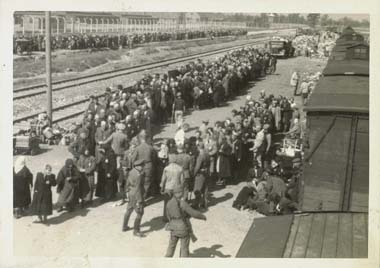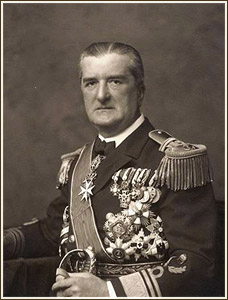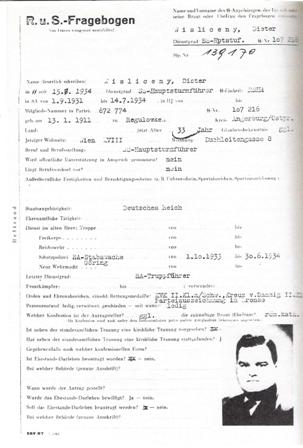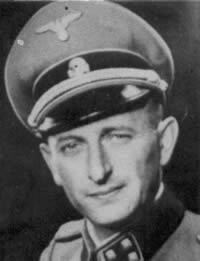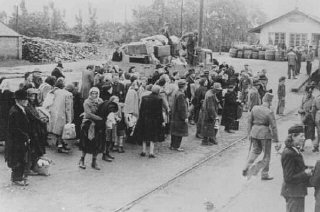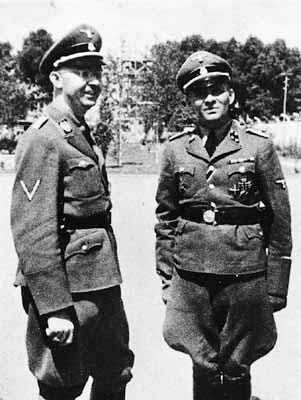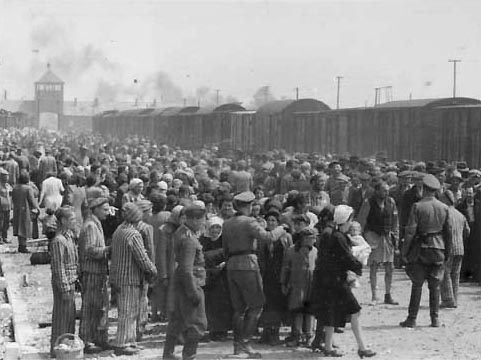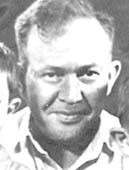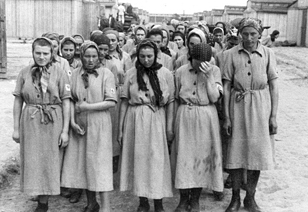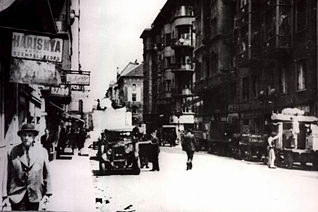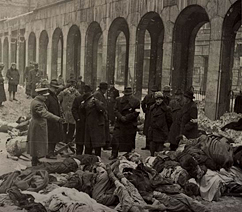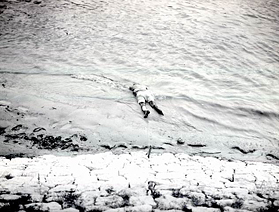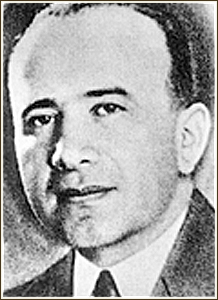Holocaust Education & Archive Research Team |
|
Other Camps
Key Nazi personalities in the Camp System The Labor & Extermination Camps
Auschwitz/Birkenau Jasenovac Klooga Majdanek Plaszow The Labor Camps
Trawniki
Concentration Camps
Transit Camps | |||||||||||
The Destruction of the Jews of Hungary
At the Wannsee conference in January 1942 Reinhard Heydrich had used a figure of 742,800 for the Jews of Greater Hungary, and by the time of the deportations to Auschwitz
On 17 April 1943, the Regent of Hungary, Admiral Horthy visited Hitler at Klessheim Castle to discuss the terms on which Hungary would remain in the war.
Horthy when reproached with his policy towards the Jews retorted that having deprived the Jews of nearly every means of getting a living, he could not “beat them to death”.
At this Joachim von Ribbentrop declared that they must either be killed off or sent to concentration camps. Thereupon Hitler delivered a monologue, recorded in the minutes of his interpreter Dr Paul Otto Schmidt.
“In Poland, this state of affairs had been fundamentally cleared up. If the Jews did not want to work, they were shot. If they could not work, they had to be treated like tuberculosis bacilli, with which a healthy body may become infected.
This was not cruel, if one remembers that even innocent creatures of nature, such as hares and deer, which are infected have to be killed so that no harm is caused by them.
Why should the beasts who wanted to bring us Bolshevism be spared more? Nations who did not rid themselves of Jews perished. One of the most famous examples is the downfall of that people who were once so proud, the Persians, who today lead a pitiful existence as Armenians.
These minutes which are indisputably genuine contain Hitler’s only recorded outright admission of the massacres in Poland. It should be noticed that even in this bald statement, shooting is specified and that Hitler made no allusions to the death camps, unless the comparison to tuberculosis bacilli is to be regarded as an oblique reference to Zyklon B, which was used to kill vermin.
On 19 August 1943 when Prime Minister Kallay broadcast a speech on Hungary’s need for peace, the country was virtually out of the war. Paradoxically, it was only by retreating that the Germans could once more dictate to Hungary. Thus on 16 March 1944 Hitler extorted from Horthy a promise to dismiss the Kallay Government and this was just three weeks before the first Soviet Army patrols reached the foot of the Jablonica, the historic “Tartars” pass into the Hungarian plain.
On this, his second visit to Schloss Klessheim, Horthy was practically arrested, being detained twenty-four hours while he considered the terms of Hitler’s ultimatum.
Hitler told Horthy that the Kallay Cabinet had been in touch with the British. The aerodrome surrounding the capital would therefore have to be occupied by German troops.
Horthy would have to take orders from a German plenipotentiary and there would be German Security Police force in Hungary under a Higher SS and Police Leader.
Gruppenfuhrer Otto Winklemann was appointed to this post, Hitler’s terms of appointment were precise, he was “to perform tasks of the SS and Police concerning Hungary and especially political duties in connection with the Jewish problem.”
At the Nuremburg trial the former Reich plenipotentiary for Hungary Edmund Veesenmayer testified that when he reached the Budapest Embassy on 23 March 1944, Winklemann and his chief Ernst Kaltenbrunner were already in possession.
But the plea that Veesenmayer had no authority over Winklemann has little relevance to the deportations, since they were carried out by Adolf Eichmann in person, ensconced in the Majestic Hotel.
As to Veesenmayer and Winklemann they played the part of compliant stooges while Himmler’s orders were carried out. Horthy had been blackmailed not to keep Hungary in the war, since that, for what it was worth, had been guaranteed by the Russian advance.- but to remove 800,000 Jews from a country that was about to become a battlefield.
According to Eichmann’s assistant, Dieter Wisliceny, the Einsatzgruppe of the police, which was intended for Hungary, together with almost the entire staff of Eichmann’s office, had assembled – at Mauthausen concentration camp of all places – as early as the beginning of March 1944.
This complete transportation of the most secret of departments shows the immense importance which the destruction of Hungarian Jewry held in Hitler’s mind.
In Hungary where he arrived at the end of March 1944, Eichmann had, for the first time since his appointment as Grand Inquisitor of the Jews of Europe, to work in the open, since he was to keep in close and constant touch with the Hungarian Ministry of the Interior.
It is for this reason that Eichmann’s service record describes him on 5 September 1944 by the fictitious title BdS Ungarn, or Commander of the Security Police Hungary.
Thus there evolved a new Eichmann, not the cautious sly German bureaucrat described by Wisliceny, but a cynical drunkard and corrupt satrap of the SS, displaying his smart mistress and his horses.
On 20 March 1944 SS- Sturmbannfuhrer Hermann Krumey who had served in the Umwandererzentralstelle Litzmannstadt (Lodz) and was responsible for “germanising “ the Warthegau, and now worked for Eichmann in Vienna, summoned the leaders of the Budapest Jewish community.
Their apprehension was so great that they had brought their families and their luggage, but they were assured that no one would be arrested. Indeed the Jews who had been arrested overnight at the railway station would be released.
The next day Krumey and Wisliceny selected a new Jewish Council, headed by Samuel Stern, who was believed to enjoy the friendship of Admiral Horthy, the Gestapo’s Jewish experts might well have been believed when they said that “all would go on as before.”
Disillusionment came not via the Gestapo but via the Hungarian Government – on 22 March 1944 Sztojay now promoted Premier, told his Cabinet that Kaltenbrunner had insisted on the establishment of ghettos in the main Hungarian towns and the wearing of the Jewish Star.
Kaltenbrunner left Hungary on 26 March 1944, after securing three more appointments that boded no good for Jewry. Two men who had been active in the “Arrow Cross” or Hungarian National Socialist movement, Laszlo Baky, and Laszlo Endre, were to run a Jewish Commissariat in the Ministry of the Interior, while another “Arrow Cross” man, Major Ferencsy was to convey orders to the Hungarian gendarmerie from the German Security Service.
On 31 March 1944, the Jewish Council had their first interview with Eichmann at the Majestic Hotel. Eichmann asked the question; “Do you know what I am?” “I am a bloodhound”
Other witnesses found him rather slyer, asserting that he never occasioned executions anywhere, except when Jews had been linked with resistance movements.
Having told the Council members that they might sleep in their beds at night, he asked to see the Jewish museum and library matters, which had interested him since 1934.
On 7 April 1944 the first orders for arrests were issued for rounding up Jews in the areas that were least Hungarian. Round-ups of 15 and 16 April 1944 took place at Ungvar and Munkacs in Ruthenia and at Nagy – Kanisza near the Croat border, all of those places were now in combat areas.
On 15 April Veesenmayer expected only 5,000 Jews to be produced for deportation every three or four days. Two days later it was to be 50,000 Jews for labour in the Reich in April and 50,000 in May.
Sztojay still expected to keep a labour force of 100,000 to 150,000 Jews in Hungary, but Baky, Endre and Ferencsy taking their orders from the Eichmann commando, confined the Jews in such appalling quarters that they became an impossible burden to the civil administration – the classic methods invented by Heydrich, and expertly copied by Eichmann.
It is unlikely that Horthy personally gave the order that the mass of interned Carpathian Jewry should be removed to Germany for, as we have seen, he had washed his hands of the whole affair.
According to Wisliceny, Ferencsy visited Eichmann’s office as early as the 20 April imploring Eichmann to take the Jews off the hands of the Ministry of the Interior. Wisliceny declared that Eichmann had the railway officials waiting in the next office and that Rolf Gunther at once telegraphed Gruppenfuhrer Glucks, Inspector of Concentration Camps, to get ready at Auschwitz.
Ferency’s version – was that between 24 April and 28 April Endre accompanied Eichmann and Wisliceny on an inspection at Kosice, Ungvar, Munkacs and Marmaros – Sziget.
At each of these places, 15,000 to 25,000 Jews huddled miserably in brickfields. Wislency proposed moving the Jews to the centre of Hungary, but Endre protested that there was nowhere to put them. He was persuaded by Eichmann that they had all better go to Germany.
Eichmann afterwards told the Budapest Jewish Council that “it was the fault of Endre, who wanted to eat the Jews with paprika.” Veesenmayer reported to Ribbentrop on the progress of the round-up on 24 April wrote that from 15 May 1944 the Jews would be shipped to Auschwitz at the rate of 3,000 a day.
By 5 May 1944 the figures of the round-up had reached 200,000 – Veesenmayer reported on a conference in Vienna between the Security Police and the German State Railway officials, at which the latter had agreed to release enough rolling stock to bring 12,000 Jews to Germany every day in four trains.
This was four times the quota that had been proposed on 24 April – an indication that the selection for labour would now take place in Germany itself.
Reports by Auschwitz survivors suggest that preparations for the reception of Hungarian Jews were made back in April 1944. A story reached the Jewish Council in Budapest from Bratislava that the crematoria were being overhauled and that the SS guards at Auschwitz, were saying that “Soon we will be eating fine Hungarian salami.”
Indeed in all their negotiations with the Eichmann commando, the Jewish delegates in Budapest were never in any doubt as to the final destination of the deportations. One transport had already reached Auschwitz on 28 April taking close on a thousand Budapest Jews who had been detained since 19 March under various pretexts in Kistarcsa barracks.
This “political” transport was not selected for the gas chambers. There were, however, no mass round-ups in Budapest till the end of June – beyond the wearing of the Jewish Star, life went on as normal for the majority of Budapest Jews, whilst in Ruthenia and the Carpathians conditions grew desperate by the day.
In connection with the start of the destruction of the Hungarian Jews, former Camp Commandant Rudolf Höss returned to Auschwitz, as SS Camp Senior, and the action against the Hungarian Jews, became known as “Operation Höss”.
On 9 May 1944 SS Camp Senior Höss announced a series of directives, such as the construction of a three track rail spur and ramp, in Birkenau itself, the inactive cremation ovens in Crematorium V be put in operation, incineration pits dug, Bunker 2 to be put back in operation with disrobing barracks, and that SS – Hauptscharfuhrer Otto Moll was promoted to Director of all Crematoriums.
On 15 May 1944 when the main deportations began Baky reported that 320,000 were concentrated in the camps and ghettos east of the River Theiss. At Munkacs where 30,000 Jews were herded into a camp and a few miserable streets there was already a typhus epidemic.
Conditions were scarcely better in the former Rumanian towns of Cluj and Oradea. The first trains therefore, were packed to capacity and von Thadden reported that 116,000 Jews had left in nine days. Even in four trains a day of 45 box-cars each, this meant more than 65 passengers to a box-car.
Eichmann explained to Dr Kastner that, if 90 people were sometimes loaded into one wagon, it was because Ruthenian Jews had plenty of children who took up very little room. Besides “the Jews in those regions were not pretentious.”
Thus some 380,000 Jews were deported by 30 June 1944 – the rounding-up was undertaken by the Hungarian Gendarmerie or by the Jewish Community Councils acting under orders and threats. The Gendarmerie guarded the trains as far as the Slovak border, having previously carried out the obscene searching of women for valuables.
Eichmann’s assistants, Wisliceny, Krumey, Nowak and Hunsche went to work with no German police at their disposal. Furthermore, according to Wilhelm Hottl, who maintained close contact with Eichmann in Budapest, the number of the Hungarian gendarmerie employed was quite small.
The trains entered Slovakia at Presov then took a choice of routes following windy, single tracked lines through lonely wooded Carpathian valleys, where escapes had a good chance of success, yet few escapes were attempted.
Judith Sternberg a Jewess from Hungary, later recalled the moment of arrival at Birkenau:
“Corpses were strewn all over the road – bodies were hanging from the barbed wire fence. The sound of shots rang in the air continuously. Blazing flames shot in the sky – a giant smoke cloud ascended above them. Starving, emaciated human skeletons stumbled towards us, uttering incoherent sounds. They fell down right in front of our eyes, and lay there gasping out their last breath.”
With each arriving train from Hungary, selections were made, and some men and women, who could work, were admitted into the camp. But within a few days, twelve thousand Jews were being gassed and cremated every twenty-four hours.
Alter Feinsilber one of the few survivors of the Sonderkommando at Birkenau, noted of these Hungarian transports:
“If the number of persons to be gassed was not sufficiently large, they would be shot and burned in pits. It was a rule to use the gas chambers for groups of more than two hundred persons, as it was not worthwhile to put the gas chamber in action for a smaller number of persons.
It happened that some prisoners offered resistance when about to shot at the pit or that children would cry and then SS- Hauptscharfuhrer Moll would throw them alive into the flames of the pits.
I was eye-witness of the following incidents:
“Moll told a naked woman to sit down on the corpses near the pit, and while he himself shot prisoners and threw their bodies into the flaming pit, he ordered her to jump about and sing. She did so, in the hope of course of thus saving her life, perhaps. When he had shot them all, he also shot this woman and her corpse was cremated.”
Höss estimate that 400,000 Hungarian Jews were gassed in the summer of 1944, but this figure is clearly too high. Of the 381,600 Jews who left Hungary between 15 May 1944 and 30 June 1944 it is probable that 200,000 – 240,000 were gassed or shot on 46 working days.
One of the most infamous episodes resulting from the destruction of the Hungarian Jews was the Joel Brand affair. Joel Brand was a Jewish representative of the Joint Distribution Committee was summonsed to meet Eichmann on 5 May 1944, along with Dr Rezsoe Kastner, where Eichmann made an astounding proposition. Brand was to be taken to Istanbul in order to transmit to the Allies an offer to trade the Hungarian Jews for heavy trucks.
For a fortnight, the whole of Hungarian Jewry would be guarded alive in Germany in suspense. This crazy mission actually left Vienna for Istanbul on 19 May 1944 – just after the deportation action commenced in earnest, a fact Joel Brand was painfully aware of.
Brand was accompanied on this trip by Bandi Grosz, who though was a Jew , was an agent both of Hungarian military intelligence and of the German Abwehr. Brand- in a ghost-written book, claims that he never deceived himself. He did not believe that the Allies would really accept hundreds of thousands of Jews from the Germans, or hand over thousands of precious military vehicles in their place.
He did however hope that by prolonging talks at a high official level, the mass destruction of Hungarian Jewry could have been postponed until the Germans were driven out of most of Hungary.
For one who had first-hand experience of Eichmann it was a naïve belief, compounded by the belief that the shady company of Bandi Grosz, who claimed to have good contacts in Istanbul, would gain Brand speedy access to the British authorities in Turkey.
Brand’s story is one of continuous frustration. Having achieved nothing in Istanbul save his expulsion from Turkey, he was arrested by a British military intelligence unit at the Turkish- Syrian border, and taken to a villa near Cairo, where he was kept prisoner.
He was however, allowed a visit from Moshe Shertok (Sharett), of the Jewish Agency who transmitted his proposals to London.
In the interests of propaganda they were released to the press on 19 July 1944 when it appeared that Himmler had asked for 10,000 trucks to be shipped to Salonika – “for use only in Hungary.”
On 29 August 1944 Horthy at last dismissed Sztojay and appointed General Lakatos as Premier. The Regent at once assured Samuel Stern, President of the Jewish Council that there would be no deportations from Budapest and no universal commitment to labour camps.
On 22 September General Faragho’s armistice mission left for Moscow – on 9 October 1944 Molotov’s terms were received and the Russians halted on an agreed line, at Kecskemet some 50 miles from Budapest.
Hardly had Horthy announced his surrender to the Soviets in a Sunday morning broadcast, when Veesenmayer visited him, bringing Rudolf Rahn, the German plenipotentiary for Italy.
Horthy was informed that his son Miklos was a Gestapo hostage, having been trapped into meeting an alleged agent of Marshal Tito. This was none other than Himmler’s kidnapping expert, Otto Skorzeny, who carried him off with two Russian agents rolled up in carpets.
Horthy was also told by the two plenipotentiaries that von dem Bach- Zelewski, the victor over the Warsaw rebels was on his way to batter in the Hofburg Palace with forty-two Tiger tanks.
Veesenmayer and Rahn had already persuaded Colonel Szalasy to form a new National Assembly at Estergom from the Arrow Cross Party. Rahn after this announcement relented to the extent of allowing Horthy 24 hours for an answer and he even offered to persuade the Wehrmacht to withdraw beyond the Reich frontier. Finally, Horthy agreed to nominate the Szalasy Government, if his son was restored to him. Horthy and Lakatos were then driven off in a car for internment in Germany.
On 2 November 1944 the Russians gained a temporary footing in the suburbs of Pest, which had however, been cleared of Jews. The new situation was considerably worse for the Jews of residual Hungary, since the 200,000 who still lived in Budapest and West of the Danube, now came under the yoke of the Arrow Cross Party, among whom Gabor Vajna, the new Minister of the Interior, had sworn to carry out the deportations without exception or foreign protection.
Ferencsy was in charge and before the end of the month, Hunsche of the Eichmann commando returned to Budapest. Even at the end of June the outlook had not seemed blacker, but there was a difference. The Szalasy Government was the feeblest possible. Led by a crazy tub-thumper, it was despised by the Germans and unrecognised abroad.
It had no standing in the country and it could not control its own “Green Shirt” blackguards. The “Arrow Cross” killed Jews both on the notorious death march to the “East Wall”, and during the siege of Budapest, but never on the scale of German –controlled exterminations.
On 2 November 1944, when the Russians were in the suburbs, the Jewish labour companies were withdrawn west of the Danube, as a security measure. This apparently innocent manoeuvre was followed on the 8 November 1944 by an indiscriminate expulsion of Budapest’s Jews who, regardless of age and sex, were marched 120 miles to the now notorious reception camp at Strasshof near Vienna. Thus began the last mass deportation of free Jewry in Hitler’s Europe.
Obergruppenfuhrer Max Juttner of the “Leadership Office” of the SS, together with Höss of Auschwitz, who was now deputy inspector of concentration camps. They were to watch the march and report back. One wonders whether the humanitarian feelings of the former commandant of Auschwitz were as badly shattered as he made out in his Nuremburg affidavits and his prison memoirs of 1946-47.
Juttner when his turn came to give evidence, at least claimed to have done something about it. “Two- thirds of the way to Budapest, we saw columns of Jewish women up to sixty years old, escorted by Honved guards. There were many stragglers lying in the road in the intervals between the columns.
Winklemann told me he was powerless in the matter and would be grateful if I would take it up. I was told that the man responsible was Eichmann. I was aware that I might incur disagreeable consequences in sending for him, but he was not in Budapest, so I saw a Hauptsturmfuhrer whose name I do not recall and told him his business.
He said he was not under my orders, and I threatened to inform Himmler in order that this wrong, which cried to heaven, should be put right. Three days later I sent Himmler a strong report – apparently without result.” Eichmann returned to Budapest on 23 November 1944 furious stating that only 38,000 instead of the 70,000 promised by Szalasy, and wanted 20,000 Jews to report voluntarily.
On 29 November 1944 Oberfuhrer Geschke the commander of the German Security Police in Budapest demanded a further 17,000 Jewish workers. They were allowed to travel to the Austrian border by train, but Eichmann now threatened to deport every Jew in Budapest if the twenty-million francs collected by the Joint Distribution Committee was not handed over.
Eichmann was informed that five –million francs had been deposited and on 6 December 1944 a huge train steamed into Bregenz bringing 1368 Jews including Kastner’s family.
Although Himmler did not get his five-million francs till February 1945, the deportations ceased. Raoul Wallenberg the special envoy of the King of Sweden reported on 8 December 1944 that 40,000 Jews had been deported only 15,000 of those who were enrolled as labourers.
But a further 15,000 had been rescued by the agents of the neutral powers, the Red Cross and the Papal Nuncio. These had returned to Budapest.
Only a small proportion of the 38,000 deportees to Austria returned to Hungary after the war. Wisliceny stated they were completely emaciated and exhausted after their march. The 10,000 Hungarian Jews who remained on the Austrian border to dig and quarry for the “South East Wall” which covered Vienna fared no better. Like the Hungarian Jewesses, digging along the “Eastern Wall”.
In Prussia and Poland, they were expandable and worked in conditions of atrocious neglect. In Budapest about 63,000 Jews who possessed no protection certificates were moved after 29 November into an enclosed ghetto which contained only 162 apartment houses.
Into this crawling hive of misery Vajna tried a month later to remove the children’s orphanages. The Red Cross supported by the Nuncio and the Corps Diplomatique, succeeded in stopping this. They were equally successful, thanks to the efforts of Raoul Wallenberg, at the beginning of January 1945, when Vajna proposed to move in the 33,000 Jews of the “protected houses.”
From the memoirs of Gyorgy Konrad:
“One day the Swiss consul Carl Lutz started to hand out to the Jews of Budapest “Schutzpase”- his name is less often mentioned than that of Swedish diplomat Raoul Wallenberg, although he saved just as many Jewish lives as his colleague.” The “Schutzpase” were official papers in which was stated that the person was living in a house that stood under the protection of the Embassy of Switzerland, Sweden, Spain, Portugal and the Vatican also used this method.
It mainly benefited those Jews who belonged to the well to do, educated and liberal Jews. The poor orthodox Jews – men with black beards and hats, women with kerchiefs, boys with long side-locks and girls with gazelle eyes – moved to the ghetto. The Budapest ghetto was kind of a hunting ground that was passed from time to time by drunken Arrow Cross militia men who shot at the Jews just as they pleased.”
The Jews were not permitted to leave the protected houses, a girl who lives in the same house as Konrad, does not obey this rule and is taken by Arrow Cross men to the Danube quay, together with her aunt Sara.
It is January 1945:
“When they got to the river, the Jews had to empty their pockets and stand along the river quay with their hands up. Before them they saw the bald trees on Margaretha’s bridge. The aunt was shot and fell forward into the Danube but Klara the little girl stayed alive as by a miracle. “You’re lucky my magazine is empty”, said the Arrow Cross man, who carried a machine gun with an almost friendly smile. “Beat it and behave decently at home.”
Henryk Slawik a Polish diplomat also rescued several hundred Jews in Polish centres, schools and orphanages, and he deserves to be mentioned. After the Hungarian government issued racial decrees and separated Polish refugees of Jewish descent, Slawik started to issue false documents confirming their Polish origins and belonging to the Roman Catholic faith.
He also helped several hundred Polish Jews to reach the Yugoslav partisans, another of his initiatives was the creation of an orphanage for Jewish children in Vac. To help disguise the true nature of the orphanage, the children were visited by Catholic Church authorities, most notably by nuncio Angelo Rotta.
After the Nazis occupied Hungary in March 1944 Slawik went underground and ordered as many of the refugees under his care to leave Hungary. All of them were able to escape and leave Hungary. The Jewish children of the orphanage in Vac were also evacuated. Slawik was arrested by the Germans on 19 March 1944. Although brutally tortured he did not betray any of his colleagues, and he was sent to the concentration camp at Mauthausen, in Austria.
He was executed in Mauthausen probably in August 1944, his wife also arrested by the Germans survived the hell of the concentration camp for women at Ravensbruck, returned to Hungary after the war and found their daughter hidden by the Antall family.
It is estimated that Henryk Slawik helped save as many as 30,000 Polish refugees in Hungary, approximately 5,000 of this number were Jews. In 1990 the Yad Vashem Commemorative Authority honoured Slawik with the title of “Righteous Among the Nations.”
Pest was entered by the Russians on 16 and 17 January 1945, Buda not till four weeks later. A few days before the siege began, Eichmann made a brief appearance when he tried to arrest the Jewish Council members.
In this he failed, but there still remained enough SS during the siege to do his work and the two most energetic members of the Jewish Council Otto Komoly and Janos Gabor were executed. Moreover, on the eve of the fall of Pest, a plot was concocted between the German Security Service and the “Arrow Cross” leadership to liquidate the ghetto. M. Levai claims that this was frustrated by General Schmidthuber of the Feldherrnhalle Armoured Division.
Capitulation did not end the troubles of the Jewish community, for the foreign legation staffs and Red Cross representatives, who had done so much to help them, were ordered to leave by the conqueror of Hungary, Marshal Malinovsky. It became impossible to use the funds allotted by the Joint Distribution – it was on this account that Raoul Wallenberg set off on 17 January 1945 with two Russian officers to seek Malinovsky in his headquarters at Hergyeshalom.
Raoul Wallenberg fate is shrouded in mystery, some claim he died in Russian captivity in 1947 from a heart attack. Perhaps the truth will never be known, but that simply lies with the Russian authorities to end the mystery. Under a Communist – dominated Government, the persecutors of Hungarian Jewry were given the appropriate punishment, four Prime Ministers Imredy, Bardossy, Sztojay, and Szalasy were shot or hanged .
Almost the whole of the Szalasy Cabinet including Gabor Vajna were also executed, among 122 death sentences were the four greatest Jew-baiters, Jaross, Baky, Endre and Ferencsy. Most of these men were tried early in 1946 after extradition from the American Zone to Germany. Horthy died in 1957 at the age of 89 at Estoril in Portugal.
Sources:
The Final Solution by G. Reitlinger – Vallentine Mitchell &Co Ltd 1953 . Auschwitz Chronicle by Danuta Czech published by Henry Holt New York 1989 Justice not Vengeance by Simon Wiesenthal published by Weidenfeld and Nicolson London 1989. Elutazas es hazateres by Gyorgy Konrad USHMM
Copyright 2007 SJ & Carmelo Lisciotto H.E.A.R.T
|
